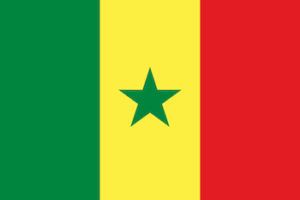
Senegal Flag
*On this date in 1960, Senegal and French Sudan merged to form the Mali Federation, which became fully independent.
Senegal was first colonized during the 15th century by major European powers: the French, Dutch, Portuguese, and British. It is also the location of Goree Island, one of the first ports of departure for the Middle Passage of slavery to the Americas. It was also incorporated into the focus of French colonization following the Berlin Conference. That episode marked the high point of white European competition for African territory, a process commonly known as the Scramble for Africa.
On April 4, 1959, due to a transfer of power agreement signed with France, one year later, on April 4, 1960. Due to internal political difficulties, the Federation broke up on August 20 when Senegal and French Sudan (renamed the Republic of Mali) each proclaimed independence. Léopold Sédar Senghor was Senegal's first president in September 1960. Senghor was a very well-read man, educated in France. He was a poet and philosopher who personally drafted the Senegalese national anthem, "Pincez tous vos koras, frappez les balafons."
In 1976, Senghor authorized the formation of two opposition parties; Abdou Diouf, who succeeded Senghor as president in January 1981, tentatively extended these freedoms. Former prime minister Mamadou Dia, Senghor's rival, ran for election in 1983 against Diouf but lost. Senghor moved to France, where he died at the age of 96. In the 1980s, Boubacar Lam discovered Senegalese oral history, which was initially compiled by the Tuculor noble Yoro Dyâo, not long after World War I. This compilation documented migrations into West Africa from the Nile Valley, as well as the retention of traditions by ethnic groups from the Senegal River to the Niger Delta, indicating an eastern origin.
Senegal and the Gambia joined forces to form the nominal Senegambia Confederation on February 1, 1982. However, the union was dissolved in 1989. Despite peace talks, a southern separatist group (Movement of Democratic Forces of Casamance or MFDC) in the Casamance region has clashed sporadically with government forces since 1982 in the Casamance conflict. Abdou Diouf was president between 1981 and 2000. He encouraged broader political participation, reduced government involvement in the economy, and widened Senegal's diplomatic engagements, particularly with other developing nations.
Domestic politics, on occasion, spilled over into street violence, border tensions, and a violent separatist movement in the southern region of the Casamance. Nevertheless, Senegal's commitment to democracy and human rights strengthened. Abdou Diouf served four terms as president. In the presidential election of 1999, opposition leader Abdoulaye Wade defeated Diouf in an election deemed free and fair by international observers. Senegal experienced its second peaceful transition of power and its first from one political party to another.
On December 30, 2004, President Wade announced that he would sign a peace treaty with the separatist group in the Casamance region. This, however, has yet to be implemented. A round of talks took place in 2005, but the results have yet to yield a resolution. In the early 21st century, violence subsided, and President Macky Sall held talks with rebels in Rome in December 2012. Senegal celebrates their independence annually on April 4th